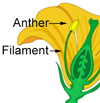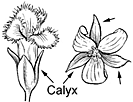Ti Plant
Cordyline fruticosa
Camas/Triteleia/Yucca family (Asparagaceae)
Polynesian introduction
Ti (pronounced “tea”) is an shrubby plant apparently introduced by the early Hawaiians for its many uses. It is related to halapepe or golden dracaena, Dracaena aurea, which it resembles slightly. Characterized by a slender trunk, few wide-spreading branches (none when small), and clusters of many very large, longstalked narrowly oblong or lance-shaped leaves crowded in spiral.

©2012 Forest And Kim Starr
Leaves are but very crowded in a spiral at the end of erect stout hairless branches, with stout grooved greenish leafstalk of 2–4 inches (5–10 ), hairless. Blades narrowly oblong, 7–18 inches (18–45 ) long and 2–4 inches (5–10 ) wide, broadest near middle and gradually narrowed to long-pointed ends, not on edges, thin and flexible, with many long fine parallel veins, shiny green on both surfaces, leaving a ring scar.
Flower clusters () are large, arising from the center of clusters of leaves, 12–15 inches (30–38 ) long, curved and branched. Flowers many, stalkless on slender drooping branches, from narrow whitish buds 1⁄2 inch (13 ) long, tinged with purple, composed of narrow whitish tube with six pointed curled back, six yellow spreading inserted in and white with three-celled and slender
(berries) rarely formed, about 1⁄4 inch (6 ) in diameter, yellow, turning to bright red. Seeds are few, shiny black.
This species served the original inhabitants in many ways. The papery leaves provided food wrapping, plates, drinking cups, bandages, leis, religious symbols, and thatch for roofs and walls of houses. They were made into raincoats and sandals. In the late 1800s, King Kalakaua introduced from the Gilbert Islands a technique of shredding the leaves into skirts for dancing the hula. Whistles and flute-like musical instruments were made from rolled strips of fresh leaf. The leaves provided fodder for livestock also. The leafy stem was and still is used as a sled for “ti leaf sliding.” One sits on the leaf, grasps the stalk, then toboggans down wet hillsides.
The plants have a large tuberous root that weighs as much as 300 pounds (136 kilos) and stores sugar. The edible baked roots taste like molasses candy. From the Europeans, the Hawaiians learned to distill brandy and whisky from the baked fermented roots. This beverage called okolehao is sold in stores at present.
Ti plants are favorite ornamentals and are easily propagated from cuttings. Numerous cultivated varieties have been developed with purple, pink, and striped leaves, also red flowers. A table decoration of sprouting leaves and roots is made by placing short stem cuttings in water.
This useful species was the subject of various stories and legends. A hedge of these plants around a house was believed to ward off evil spirits and bring good luck. Common through the islands at low altitudes, around houses and in open areas bordering wet forests.
Special areas
Waimea Arboretum, Foster, Haleakala, City, Volcanoes, Kipuka Puaulu, Hawaii
Range
Widespread in Pacific Islands, Australia, tropical Asia, and planted through the tropics, the original native range uncertain.
Other common names
ki, la-i, dracaena, common dracaena
Botanical
Cordyline terminalis (L.) Kunth.







